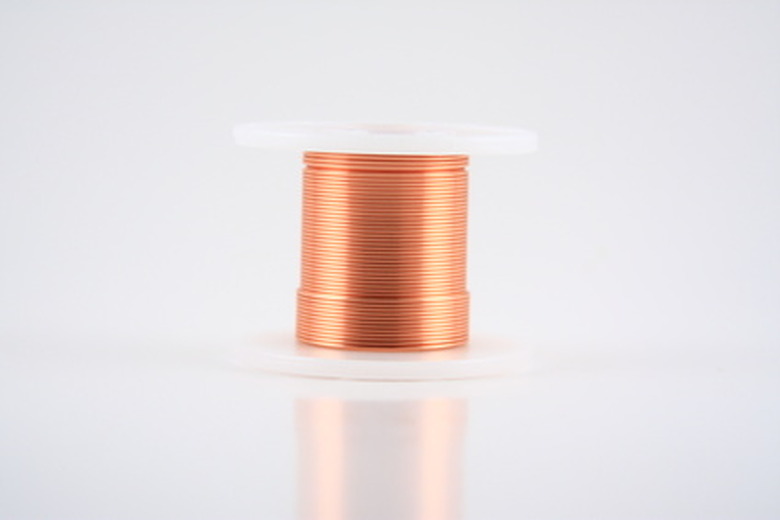How To Find Buried Copper Wire
Underneath most front yards, there is likely to be buried copper wiring of one sort or another. Television cables, phone lines, electrical cables and the electrical wires for irrigation systems all get buried underground. Other underground utilities include water, sewer and gas pipes. Modern installations should have an underground copper wire attached for locating purposes, but older (and less-than-complete) installations may lack this marking wire.
This can become quite an inconvenience when you would like to dig any kind of hole in the yard; without knowing where the wires and other utilities are located, you risk cutting them. Just as frustratingly, breaks in buried wires can shut down the system to which they're attached. Breaks in water, sewer or gas lines may have much more disastrous consequences.
The first step to repairing and removing these wires is finding them, which is easy with the right equipment.
1. Acquire a Wire Locator
You can buy or rent a DIY underground wire locator. These devices are available from electrical equipment suppliers; some home-improvement stores may also offer buried cable detector rentals. There are a wide variety of such devices available, from basic units that will beep when close to a wire to advanced units that can find nicks and breaks in the wire.
2. Find One End of the Wire
Locate, if possible, an exposed end of the wire you are trying to find. If you are looking for a television or phone cable, you can catch the wire where it enters the house. Electrical wires will come into the breaker panel, while irrigation wire will run to the irrigation control box.
3. Connect Transmitter Unit
Connect the transmitter unit of a wire locator to the exposed wire end, according to the locator model's manual. This transmitter sends a signal down the wire the receiver handle can then pick up, allowing you to follow the path of the wire. Some locators will tell you the depth of the wire as well.
4. Using Receiver Unit
Turn on the receiver and carry it slowly around the area where you think the wire is. It will beep or light up to alert you when you have found the wire. Create a grid search pattern, especially in a larger yard, to be sure to cover the entire area. Mark "hits" to more accurately locate wires.
5. Using an Induction Antenna
Use a unit with an induction antenna that can be planted in the ground. This will send a signal through the ground into a wire, which the receiver can then pick up. It eliminates the need to track down the end of the wire to patch in a transmitter. Induction tracing may not be as successful, especially for pipes and lines below six feet. Reinforced concrete and well-insulated lines may prevent detection of the target.
6. Excavating Wires
Dig carefully once you have located the wire. The locator may not have exactly pinpointed the wire's depth or location, so you risk cutting it if you stomp too hard on your shovel. When using larger excavation equipment like backhoes or ditch-digging equipment, hand-digging a preliminary test hole may prevent damaging utilities.
7. Check Wires for Current
Press the probe of a multimeter to any wire before touching it. Buried live wires could be an electrocution hazard.
Metal Detectors for Underground Utilities
Metal Detectors for Underground Utilities
Finding underground electrical wires with a metal detector can be done, if the lines shallow enough. The effective depth of metal detectors depends on the make and model, soil type and conditions as well as the size of the target. Hobby metal detectors may reach deeper than a foot but using metal detectors for underground utilities location is not likely to be successful.
Make, model, soil conditions and size and type of target impact the potential depth of the ground penetrating radar, as well, but essentially the smaller the target, the shallower the effective depth.
Underground Locator Services
Underground Locator Services
Many states require using mark-out or underground utility location services. With more than 20 million miles of underground utilities in the United States, calling for mark-out before digging makes sense. Mark-out usually is a free service. Simply mark where you plan to dig (usually with paint) and then call (see Resources). Allow a few days after calling before digging.
Things Needed
- Wire locator
- Inductive antenna
- Marking paint or tape
- Shovel
- Multimeter
Cite This Article
MLA
Smyth, Joshua. "How To Find Buried Copper Wire" sciencing.com, https://www.sciencing.com/buried-copper-wire-7585387/. 24 September 2019.
APA
Smyth, Joshua. (2019, September 24). How To Find Buried Copper Wire. sciencing.com. Retrieved from https://www.sciencing.com/buried-copper-wire-7585387/
Chicago
Smyth, Joshua. How To Find Buried Copper Wire last modified March 24, 2022. https://www.sciencing.com/buried-copper-wire-7585387/
